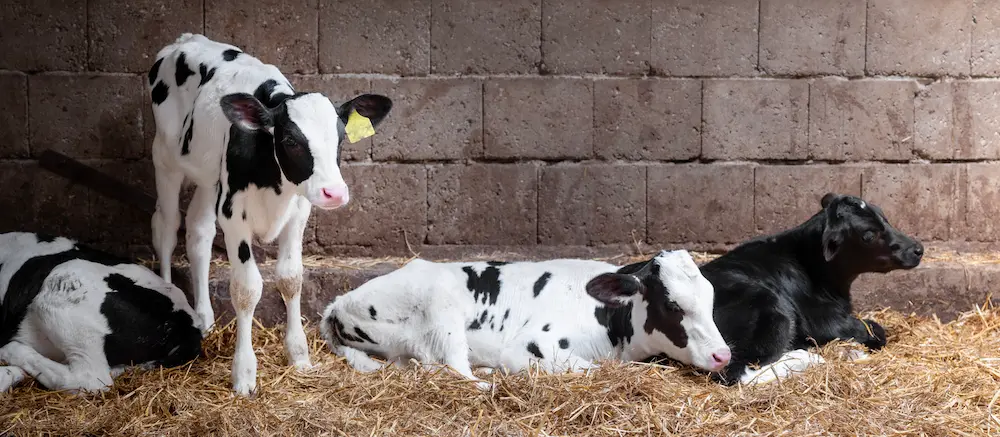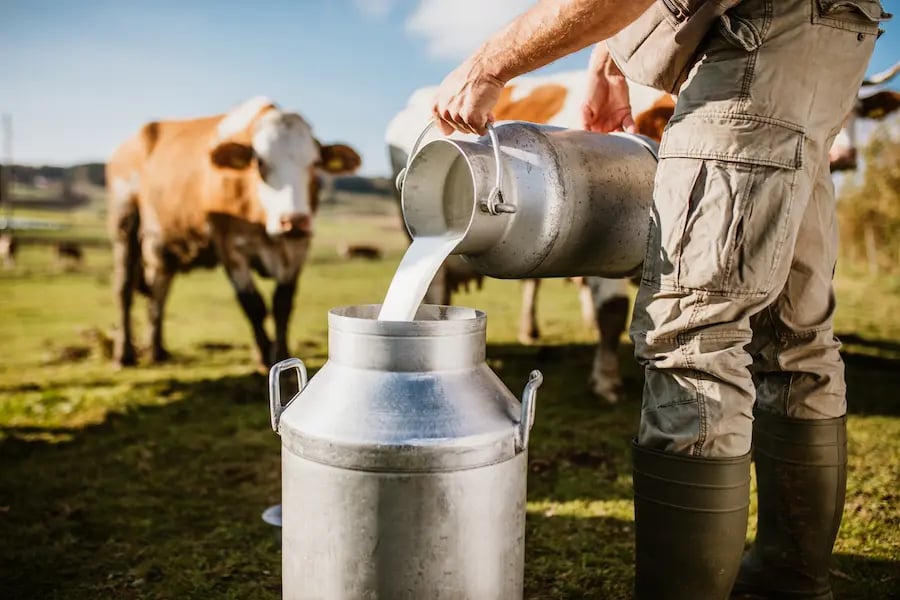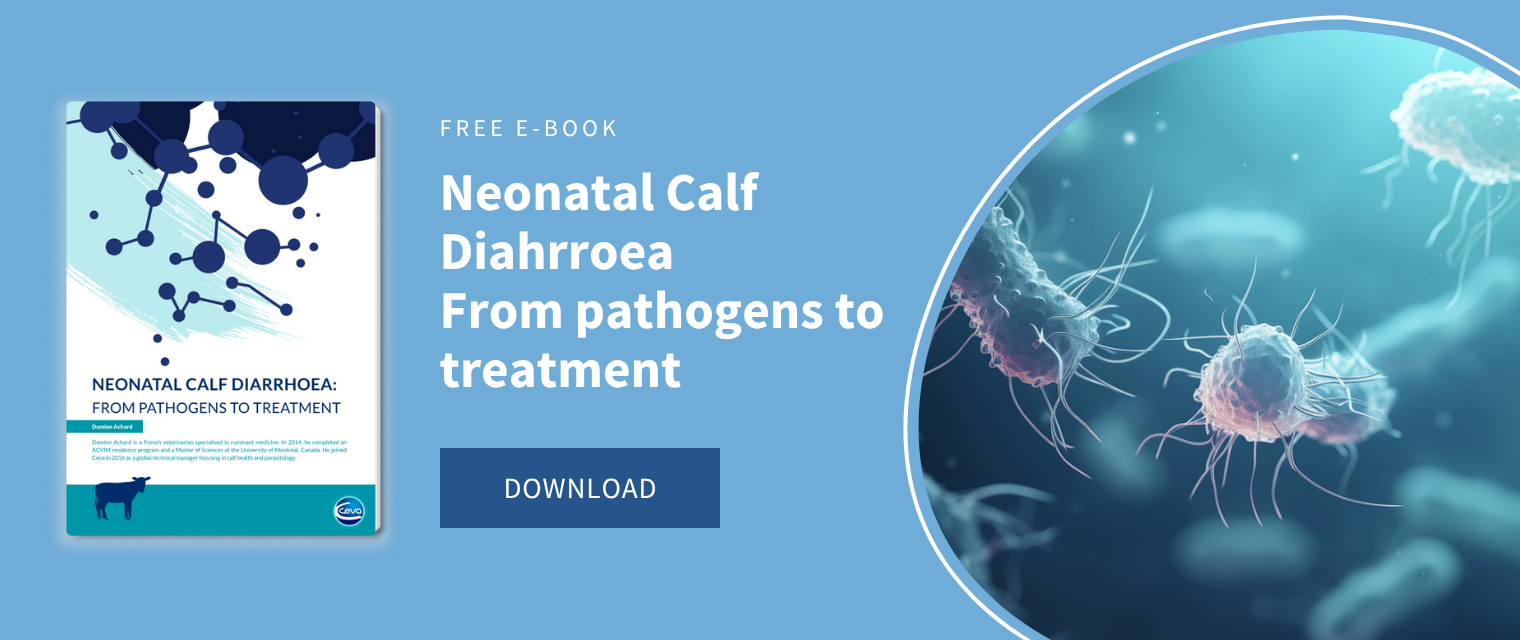Calf pneumonia, also referred as Bovine Respiratory Disease (BRD), is a leading cause of illness and mortality among dairy calves up to six months of age. Dairy farmers are often attuned to the immediate financial toll that managing BRD in calves outbreaks or endemic situations can impose. However, it is crucial to delve deeper into the long-term economic repercussions that extend well beyond the initial challenges. Still, the starting point of a discussion should be looking into the immediate costs associated with the disease.
Prefer to listen to this article? Click the play button below and enjoy our podcast!
Overview of the immediate BRD financial toll
Major factors influencing the immediate cost of BRD in a dairy herd are morbidity rates (illness), mortality rates, treatment costs and labour.
- Illness: The percentage of BRD in calves is decisive in calculating costs1. Various numbers can be sourced to evaluate the presence of calf pneumonia in dairy herds. In a large study involving 23 dairy herds from across the USA, 36.6 % of heifers had one or more BRD cases diagnosed before 4 months of age2. In a UK study, 86% of farms were found to treat their calves for pneumonia, with a mean number of treated calves of 11.3%, ranging from 0 to 100%3. It should be noted that BRD prevalence is often underestimated. When comparing traditional diagnosis with ultrasound examination, the percentage of BRD cases frequently raise to 50 to 70%4,5.
- Mortality: According to the latest USDA report, BRD accounts for 24% of deaths before weaning and 59% post-weaning6. A recent meta-analysis work finds out that BRD-affected calves had 2.85 times higher risk of dying compared with heifers not diagnosed with this condition7.
- Treatment: Mean cost per BRD case in the UK has been reported to be €4.82, ranging from €0.63 to €13.533. Treatment costs are indeed variable because these depend on the type of medications used, the number of episodes per animal, and if labour and veterinary costs are included. It is not rare for calves to receive more than one treatment. In a Canadian study for example, almost 20% of BRD cases were treated more than once8. Taken the number of treatments into account, treatment cost to treat a 84kg heifer for BRD was found to be €14.67 in North American dairy herds with 1.7 treatments per calf with BRD and including antibiotic, anti-inflammatory and labour (but no veterinary fees)2.
- Labour: Extra labour needed for farmers to take care of their calves’ sick from pneumonia is difficult to quantify but recognized as a significant contributor to BRD costs. In a Dutch economic model, a two-times increase of the farmer’s labour in case of pneumonia resulted in an increase of the total losses following the disease of 20.7%1.

Why long-term economic repercussions should be scrutinized?
An important part of the economic viability of dairy heifer rearing is intricately tied to the short-term “disease” variables mentioned above. However, it is more and more recognized that the financial soundness of a dairy operation is also dependent on the impacts of the dominant calfhood diseases (diarrhoea, pneumonia) on long-term variables such as reproduction performances, average daily gain (ADG), culling rates, and milk production which financial impacts extend far beyond the period of illness. Therefore, understanding these lasting effects in heifers which contracted pneumonia in their “childhood” becomes paramount as it not only influences the immediate costs but shapes the profitability of the entire herd in subsequent lactations.
Long-term effects of BRD
Major long-term factors influencing the overall costs associated with BRD in a dairy herd are decreased ADG, increased culling rates, lower reproduction efficiency and decreased milk productivity.
- Decreased ADG: This indicator is the most important factor in the cost of rearing since it drives both reproductive and productive costs. As it can be expected, BRD impacts the growth of dairy heifers and these lost growth rates may never fully recover. The most recent data available suggests ADG to be reduced by 0.07 kg per day7. Whether ADG is measured between 0 to 3 months of age or 3 to 6 months does not seem to influence the effect of BRD on ADG.
- Lower reproduction performances: When calves suffer from pneumonia and miss their growth targets, they are unlikely to meet their “repro” target weight. As a result, they may not be on track for breeding at 15 months of age and subsequent calving at 24 months of age. Indeed, several studies reported a significant gap in the age at first calving (AFC) between heifers diagnosed with BRD during calfhood and healthy heifers (mean AFC delayed by 15 days)9,10,11,12. This delay in reaching breeding weight has implications for overall herd productivity.
- Increased culling rates: Research indicates that heifers (young female cattle) with pneumonia are more likely to be removed from the herd before their first lactation compared to those without pneumonia. This means that they are more likely to be culled or sold. In the details, heifers diagnosed with BRD during calfhood are suspected to have 2.30 times higher odds of herd removal (i.e., dead, culled, or sold) before the first calving compared with heifers not diagnosed with this condition7. This is likely to significantly increase the overall cost of raising replacements in the herd.
- Decreased milk yield: Heifers that develop BRD are recognized to have reduced days in milk over their lifetime compared to those that never suffered from pneumonia11. Moreover, pneumonia in young calves can have a direct impact on milk yield in the first lactation. A meta-analysis study found that the mean 1st lactation milk loss due to BRD was 121.2 L7. Milk losses are also observed with subclinical pneumonia; calves under two months of age with an ultrasound diagnosis of BRD-related lung consolidation produced 525 kg less milk at first lactation5.
Conclusion
When lifetime total economic costs are considered, BRD in calves emerge as a major threat to the profitability of dairy farms. To reduce its financial impact, dairy farmers with the help of their veterinarians should implement best BRD practices which include proper management, prevention and treatment of this major calfhood disease.
References
1. Fels-Klerx, H. J., Sørensen, J. T., Jalvingh, A. W., Huirne, R. B. An economic model to calculate farm-specific losses due to bovine respiratory disease in dairy heifers. Prev. Vet. Med. 2001. 51: 75–94.
2. Overton, M. W. Economics of respiratory disease in dairy replacement heifers. Animal Health Research Reviews. 2020; 21(2):143-148.
3. Boulton, A. C., Rushton, J. and Wathes, D. C. A Study of Dairy Heifer Rearing Practices from Birth to Weaning and Their Associated Costs on UK Dairy Farms. Open Journal of Animal Sciences. 2015; 5:185-197.
4. Ollivett, T. L., Buczinski, S. On-Farm Use of Ultrasonography for Bovine Respiratory Disease. Vet Clin North Am Food Anim Pract. 2016; 32(1):19-35.
5. Dunn, T. R., Ollivett, T. L., Renaud, D. L., Leslie, K. E., LeBlanc, S. J., Duffield, T. F. and Kelton, D. F. The effect of lung consolidation, as determined by ultrasonography on first-lactation milk production in Holstein dairy calves. J. Dairy Sci. 2018; 101: 5404-5410.
6. USDA. Dairy 2014, Health and Management Practices on U.S. Dairy Operations, 2014. USDA-APHIS-VS, CEAH. 2018. Fort Collins, CO: National Animal Health Monitoring System (NAHMS).
7. Buczinski S, Achard D, Timsit E. Effects of calfhood respiratory disease on health and performance of dairy cattle: A systematic review and meta-analysis. J Dairy Sci. 2021; 104(7):8214-8227.
8. Windeyer, M. C., Leslie, K. E., Godden, S. M., Hodgins, D. C., Lissemore, K. D., and LeBlanc, S. J. Factors associated with morbidity, mortality, and growth of dairy heifer calves up to 3 months of age. Prev. Vet. Med. 2014. 113:231–240.
9. Rossini, K. 2004. Effects of calfhood respiratory and digestive disease on calfhood morbidity and first lactation production and survival rates. MS Thesis. Department of Dairy Science, Virginia Tech University, Blacksburg
10. Stanton, A. L., D. F. Kelton, S. J. LeBlanc, J. Wormuth, and K. E. Leslie. 2012. The effect of respiratory disease and a preventative antibiotic treatment on growth, survival, age at first calving, and milk production of dairy heifers. J. Dairy Sci. 95:4950–4960.
11. Bach, A. Associations between several aspects of heifer development and dairy cow survivability to second lactation. Journal of Dairy Science. 2011. 94: 1052–1057.
12. Teixeira, A. G. V., J. A. A. McArt, and R. C. Bicalho. 2017. Thoracic ultrasound assessment of lung consolidation at weaning in Holstein dairy heifers: Reproductive performance and survival. J. Dairy Sci. 100:2985–2991.
About the author
Damien Achard (Ruminants Global Technical Manager)
Seasoned veterinarian, graduated from Ecole Nationale Vétérinaire de Nantes (France). After three years as a practitioner in central France, he pursued specialization in large animal internal medicine, completing an ACVIM residency and a Master of Sciences at the University of Montréal (2010-2014). Joining Semex Alliance as Health Manager for an IVF unit (2015-2016), he then transitioned to Ceva in 2016 as a Ruminants Global Technical Manager. Dr. Achard is an accomplished researcher, publishing on topics like downer cows, calf pneumonia or cryptosporidiosis and their associated therapies, and rational use of anthelmintics in ruminants. His ResearchGate profile (https://www.researchgate.net/profile/Damien-Achard/research) highlights his significant contributions to the veterinary field.
Explore author’s articles




Leave your comments here